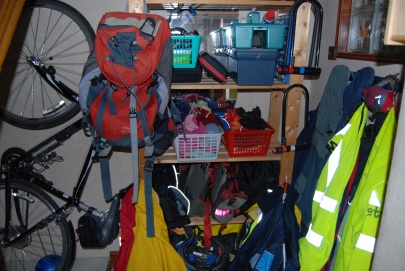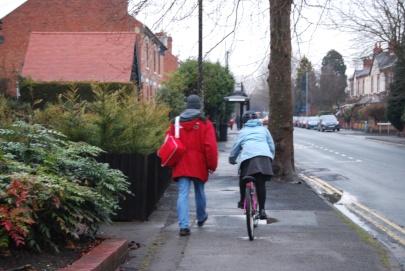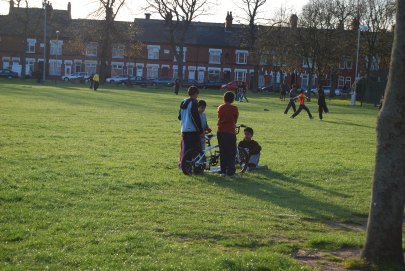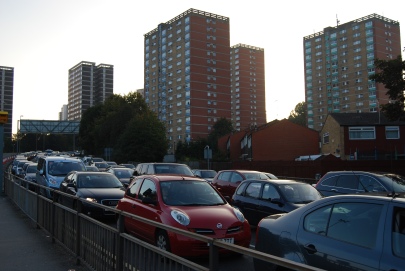“I found though, when you’ve passed your test and you get a car, you just automatically get lazy, do you know what I mean? … My brother used to say, ‘you’ll use the car just to nip to the shop’; I was like ‘no, I’d never do that’. But you do.”
(Sandra, Leeds, group discussion)
“What would make me cycle more? I think if there was more of a culture of cycling, if lots of people were doing it, I would too probably. I’d be a sheep and I’d do it. I’ve told you about my love of crowds. Being a football fan, I’m terribly susceptible for doing what is the common thing to be done, and if everybody in this street was all getting on their bikes and nipping off somewhere then I would probably be doing it as well. But when you are the only person doing it, and everyone notices you doing it, then it doesn’t have the same appeal.”
(Brian, Leeds, interview)
Cycling accounts for 2% of all trips in the UK. Just over the North Sea in the Netherlands, the figure is 26%. The Dutch have made cycling normal in a way we have not. Between 2008 and 2011 a major Government-funded research project, Understanding Walking and Cycling, investigated the reasons for UK cycling’s continuing abnormality as a short-distance mode of city transport, in order to learn how to make cycling normal. Between October 2012 and February 2013 I published nine Cycling Struggles based on the research. This summary of the series is overdue, but first let’s recall the stories:
- Rick (Cycling Struggles, 1) recently returned to city cycling after becoming frustrated with the congestion he confronted whilst driving. But along main roads and through bigger junctions – even those supposedly made ‘cycle-friendly’ – he gets off and pushes his bike. He’s not growing more confident at dealing with difficult cycling conditions, he’s refusing to engage with them. Although he’s enthusiastic, Rick’s city cycling is partial and fragile.
- Much to her surprise Nadia (Cycling Struggles, 2) is a recent convert to cycling. Her story partly demonstrates how individual agency can win out over anti-cycling structure; despite a route which has a stretch hostile to cycling and a husband who worries about her riding it, she has negotiated a cycling to work habit by sometimes accepting a lift over that worst part of her journey. Nadia’s story demonstrates how cycling is importantly mediated by the love of others.
- Fabian (Cycling Struggles, 3) stopped cycling after being knocked off his bike twice in quick succession, but three years later he’s returned to regular riding. Fabian’s story demonstrates how committed people must be to persist in cycling through anti-cycling space.
- In the abstract Holly (Cycling Struggles, 4) sees cycling as a good thing, but in practice she considers it much too dangerous and won’t ride until it’s made safe. Some of her friends cycle but current conditions prevent Holly joining them. Just seeing others cycle, let alone the thought of cycling herself, makes Holly feel uncomfortable, leading to a benign hostility to cycling which is I think widespread.
- In the deprived inner-city (Cycling Struggles, 5) cycling feels irrelevant. Affluent people might see the bicycle’s relevance as a mode of transport even as they ride almost exclusively for leisure, yet the sea of cars which these more privileged people’s everyday movements creates obliterates any view of cycling – either as transport or leisure – for people marooned in the inner-city. A few inner-cities are being gentrified and re-made for cycling, but the majority inner-city experience remains one of oppression by other people’s cars in which the bicycle’s potential is drowned.
- Cycling’s status is low within Britain’s south Asian community (Cycling Struggles, 6). As elsewhere people here have been working hard to incorporate cars and driving increasingly into their lives. How darkly ironic if now, mission almost accomplished, the game changes and they’re told the car is no longer King, Bicycles Rule! Alas no such message is being received here; so firmly in the car’s grip, why would anyone choose a practice so weird as cycling?
- Pavement cycling (Cycling Struggles, 7) is extremely easy to comprehend but highly problematic to the future of cycling. It indicates a lack of cycle-friendly infrastructure, and huge suppressed demand for cycling (if some people cycle despite having to ‘break the law’, how many more would surely do so if they could ride both comfortably and legally?). Pavement cycling tells a truth: cycling is not being promoted when people have nowhere to ride except illegally on the pavement.
- Family cycling in cities (Cycling Struggles, 8) is a margin of a margin. Cycling alone is difficult enough; encouraging children to cycle, and riding together, almost impossible. A phenomenon that ought to be central to healthy, livable cities is virtually extinct, cycling families abnormal almost to the point of deviance. That there’s so far still to go in making cities fit for cycling is underlined by the difficulty of imagining five people who currently (and invisibly) make a trip by car instead travelling together on five separate bicycles.
- Committed cyclists (Cycling Struggles, 9) are I suppose the kind of people we want everyone to become – willing and able to ride anywhere and everywhere, and certainly make local trips by bike; but they manage to do it now, in cities full of buses, trucks and cars. They have problems, but they’re not cowed by motorised traffic – they’ve learned to negotiate it, usually successfully. But these people are highly unusual in exercising such freedom of the city by bike. They are a minority because what they do is difficult; and they tend inevitably to develop strong cycling identities in the process of surviving and sustaining something so difficult to do.
Making Cycling Normal
This Cycling Struggles series has tried to paint a portrait of contemporary urban cycling. It’s neither perfect nor exhaustive, but I’d like to think it reasonably accurately reflects the present situation not just in Britain, but perhaps also other economically affluent, low cycling countries.
All the material I’ve used originated in the Understanding Walking and Cycling project. A book containing the project’s full findings is about to be published by Policy Press, as ‘Promoting walking and cycling: New perspectives on sustainable travel’. I’ve added an abbreviated version of the book’s chapter detailing findings from our qualitative work into cycling to this blog’s articles, as An Ethnography of Everyday Cycling.
To conclude I’ll say things I’ve probably said before, here and also elsewhere – on Bike Hub and in Cycle magazine back in 2011, on The Guardian’s Bike Blog earlier this year, and with John Parkin in the concluding chapter to 2012’s Cycling and Sustainability.
Things are certainly changing. The profile of cycling, including transport cycling, is growing. The cycling lobby appears to be winning more media exposure, political clout, and influence. Cycling levels are increasing in some cities, particularly central London. Cycling’s status appears finally to be going up.
But how significant and how durable are these trends? Here there are two conversations which sometimes get confused:
- Recognising how more people are cycling, the first conversation is optimistic. Here change is coming from the bottom-up, one person at a time. Efforts to promote cycling are working;
- But the second conversation is pessimistic: the brutal realities of life on the streets mean that the thought of cycling is repeatedly being knocked out of people who might cycle; this situation won’t change without a top-down paradigm shift in transport policy and practice. Efforts to promote cycling are not working.
Neither conversation is right or wrong and both are useful. For example the first makes sense when trying to encourage people to cycle; the second when we’re trying to persuade decision-makers of the need for change. The first can recognise, empower and sustain the multiplicity of grassroots projects so significant to British cycling; the second is better when arguing for huge resource reallocation in cycling’s favour.
Both conversations are required to make cycling mainstream. The first conversation needs the second because without fully embracing a more ambitious discourse oriented to everyday mass cycling it will tend towards doing what we’ve already been doing, and thus ensure cycling’s reproduction as marginal. If we only keep doing what we’ve so far been doing, cycling will remain abnormal a long time yet. Believing that cycling is inevitably on the up stops the ramping up of criticisms, ambitions and demands required to break out this trap, and make cycling normal. But the second conversation needs the first because a paradigm shift in cycling’s favour won’t happen without support from existing cycling organisations and cyclists. Those organisations and individuals have ensured cycling’s survival and have constructed the rudiments of a bicycle system which needs now to be radically improved, deepened and extended.
Final thoughts
Over the last half century urban Britain has grown used to living everyday life in and around cars. The car’s dominance over urban space has proceeded relentlessly but gradually, and people have adapted, such that they almost don’t notice. Acquiescence to the car has produced a rejection of the bicycle as an urban mode of transport. Given this context, normalising cycling requires the denormalisation of driving.
Despite occasional glimmers of hope cycling remains stuck in a vicious downward spiral:
- dire conditions make urban cycling unappealing, and more short trips get made by car. With little demonstrable demand, cycling is a low government transport priority and gets minimal funding. This lack of investment in cycling results in dire conditions …
But we could so easily switch to a virtuous upward one:
- a big boost in cycling funding alongside constraints on car use leads to a radical improvement in cycling conditions, which results in more people cycling and fewer journeys by car, leading to growth in cycling funding and further constraints on car use, encouraging still more people to cycle …
Many people like cycling and would cycle more were conditions conducive. Other people are indifferent towards cycling, but this indifference stems in large part from lack of a cycle-friendly urban environment. For urban cycling to become normal it needs to be taken seriously. Government might like us to believe it is taking cycling seriously, but it is not; it is instead still ensuring cycling is driven off the streets and remains a minority activity which can as such continue to be treated tokenistically, where/when it cannot be ignored.
Taking cycling seriously means creating environments in which cycling makes more sense than driving. Towards that end, we should be removing cars from cities; if cars ‘can’t’ be removed (this is a political rather than inevitable ‘can’t’, and one which will therefore shift over time) their number should be reduced and their speed slowed; if reducing and slowing cars ‘can’t’ be done, cycling should be prioritised by giving it sufficient space to make it obviously more attractive to cycle than to drive, so that those left driving are only those who ‘have to’. In this way we’ll make cycling normal.










































































